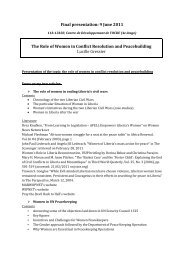Women's Economic Opportunity Index - Economist Intelligence Unit
Women's Economic Opportunity Index - Economist Intelligence Unit
Women's Economic Opportunity Index - Economist Intelligence Unit
- No tags were found...
You also want an ePaper? Increase the reach of your titles
YUMPU automatically turns print PDFs into web optimized ePapers that Google loves.
Appendix IWomen’s economic opportunityA new global index and rankingM T Ruel, A R Quisumbing, K Hallman, B de la Briere, N Coj de Salazar, The Guatemala CommunityDay Care Program: an example of effective programming, International Food Policy Research Institute:Washington DC, 2006.48. Gender Brief, OECD SocialPolicy Division: Paris, March2010.49. E James, A Cox Edwards andR Wong, “The Gender Impactof Pension Reform”, Journal ofPension <strong>Economic</strong>s and Finance,Vol. 2, No. 2, 2003.50. D Mitchell, “Income securityfor old age: evidence from eightOECD countries”, AustralianNational University, ResearchSchool of Social SciencesWorking Paper, 1993.51. E James, “Retirement AgeDifferentials and Other GenderIssues in Old Age SecuritySystems”, commissioned by theWorld Bank Gender Action Plan,forthcoming.Differential Retirement AgeLegislation in several countries specifies that women and men either must retire (mandatory retirement)or may choose to retire (statutory retirement) at different ages. The statutory retirement age is usually,but not always, the age when workers can begin receiving their pensions. The relevant indicator in theWomen’s <strong>Economic</strong> <strong>Opportunity</strong> <strong>Index</strong> measures the difference in statutory pensionable retirement agefor women and men, and accounts for both mandatory and non-mandatory retirement legislation. The<strong>Index</strong> penalises any economy that has differing retirement ages for women and men, although it scoreseconomies that have mandatory retirement ages worse than economies where retirement at a certain ageis a choice.Differential retirement age is a gender-specific social security rule. More commonly, rules do notdifferentiate between the sexes explicitly, but the same rule may affect women and men differently. Thisis because of their different demographic characteristics and employment histories. Women live longerthan men on average, but often have had fewer years in the formal labour force because of time away fromwork to bear and raise children, and to care for elderly members of the family. In addition, there remains agender wage gap in all countries. 48 Lower wages, less labour force participation and higher life expectancyadds up to lower pensions for women, which affects their financial security in later life. 49 For example, inAustralia, where the public age pension is means-tested, it is received by 85% of older women, comparedwith 65% of older men. 50Different retirement ages for women and men exacerbate these problems, and further lower thepension sums that women can expect to receive. Differences in pension amounts for women and men canalso vary greatly between defined benefit and defined contribution plans. Defined benefit plans provide amonthly pension that is based on the participant’s wages and length of service. Although such plans tendto protect women’s interests more (because they are guaranteed for life), the actual monthly amount thatwomen receive is usually smaller than for men, because women have fewer contributory years and a lowerreference age than men. In a defined contribution plan, the employer also makes a contribution duringa worker’s employment, but does not provide a guaranteed retirement benefit. Again, women are at adisadvantage because they have often worked fewer years than men, and have had lower wages duringtheir working lifetime. <strong>Economic</strong> simulations show that if a woman is required to postpone her pension forfive years in a defined contribution plan, her monthly pension will be 40-50% larger. 51Lower retirement ages for women can also inadvertently reduce their opportunities for access to skillstraining and promotions at work. Knowing that women have shorter careers, it may be less profitable forthem to invest in themselves via schooling, or for employers to provide on-the-job training. This in turnmay reduce the chance of a woman being promoted to a better job or to a management position, furtherexacerbating the cycle of lower wages and lower pensions compared with men.For example, women in China can retire five years earlier than men. This policy inadvertentlydiscriminated against women during a restructuring of the public sector in the 1990s. During this111 <strong>Economist</strong> <strong>Intelligence</strong> <strong>Unit</strong> 2010




